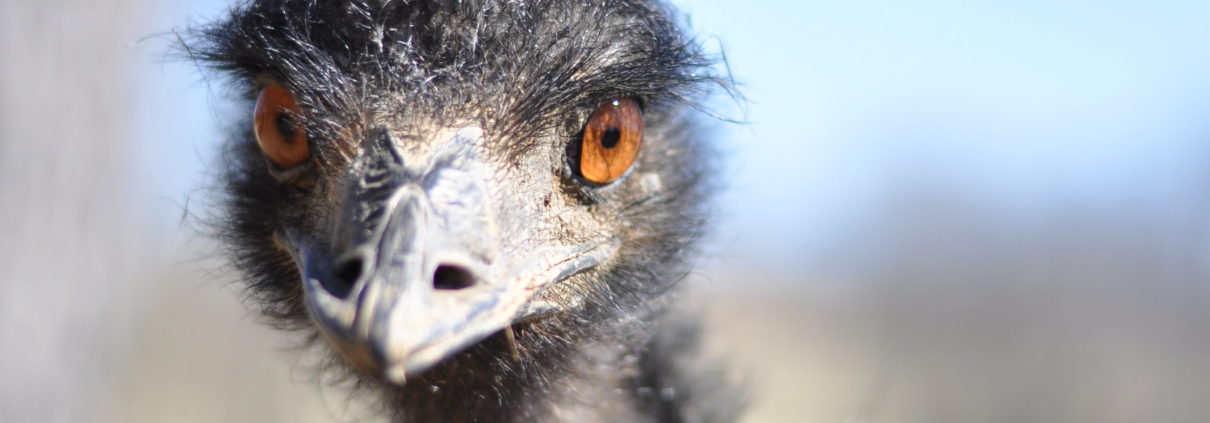Big Birds and Big Green Eggs
Story by Claire Stuart, photos by Bre Bogert
If you take a drive down Springsbury Road in Berryville, you might catch a glimpse of two huge ostrich-like birds in a field beside the road.
No, you aren’t seeing things. It’s just Big Bird and Puff, Dave and Lauren “LuLu” Conrad’s emus. The Conrads have been keeping the gigantic birds since 2006. Emus are flightless birds that are native to Australia. They grow to be five to six feet tall, weigh well over 100 pounds and live about 20 years in the wild and about 35 in captivity.
Dave Conrad explains how they came to own them. “One day my daughter called and said, ‘Dad, I’m bringing you some emus.’ She knows that Dad will take anything that’s free! At the time, we didn’t even know what an emu was.”
Their daughter was into horses, and the family of one of her friends had a riding stable. For whatever reason, they’d bought some emus and soon discovered that juvenile emus are like packrats —they love bright shiny objects. The birds were stealing items of horse tack and anything else interesting they could find. They had become a nuisance, so the owners decided to get rid of them.
“They’ll pick at people’s rings and watches,” said Dave Conrad, “and they’ll try to take glasses off your face.”
The Conrads describe Big Bird, the male, as friendly, but he gets aggressive when he has young. Puff, the female, is more standoffish. Once a clutch of eggs is laid, the male emu sits on the eggs and turns them for about eight weeks, without eating or drinking. When they hatch, he cares for the young. In the wild, the female leaves and finds another mate.
Emus can run at speeds of 30 to 40 miles an hour, zipping off in a flash from a standing start. They readily demonstrated this as they took off after a family pup who was annoying them. They defend themselves by kicking, and they have long, sharp claws. However they are generally gentle birds.
Dave Conrad explained that you can’t tell the sex of an emu by looking at it. Emu reproductive organs are internal, and trying to do an intrusive examination of a six-foot, 150-pound bird with claws like a velociraptor, while possible, is not anything most people would attempt. It is easier to do when the birds have just hatched. You can send for an expensive DNA test, or you can just wait and see, as the Conrads did. When emus reach maturity, which takes a few years, the females begin to make a drumming sound. The males just grunt like pigs.
Lauren Conrad brought out one of the emu eggs. It was huge and green and looked a bit like an avocado. “Last year we got 29 eggs,” she said. “One emu egg is equal to about a dozen chicken eggs. We don’t eat the eggs but you can. You can scramble them. We hard-boiled one, but there was too much white before you could find the yolk.”
“It took three sandwiches worth of white sliced off to even get to the yolk,” Dave Conrad recalled. The eggs are not green inside and look just like giant chicken eggs.
In this part of the country, emus only lay eggs in winter, from about November into March. In normal winters, they usually lay an egg every three or four days. In very cold winters, they lay less often. The birds are very cold hardy but they take shelter in their shed in extreme cold.
Big Bird and Puff are very curious. They like certain noises, especially the sound of a loud car exhaust, and they will run to the fence to check it out. The Conrads guess that a local young man with a noisy exhaust purposely guns his engine to get the attention of the emus when he drives by.
The Conrads were raising and selling emus for a while, but it became too much work and expense, considering the price they could get for the emu chicks. Now they only sell the eggs, which people buy to decorate. A customer arrived to pick up some eggs that she planned to use in a decorative nest.
Egg carving is also popular and has a long history as an Australian aboriginal art form. Emu eggs are particularly good for carving with a Dremel or similar tool because the thick shell has three layers of different colors. The outer layer is green, the next layer is turquoise and the inner layer is white, allowing for beautiful three-dimensional effects.
Lauren Conrad sells emu eggs at the Clarke County Yard Sales and other community happenings, or you can e-mail her at: lulupot47@gmail.com










